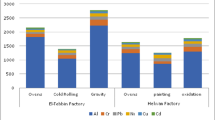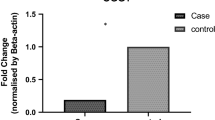Abstract
Lead poisoning is an old but persistent public health problem in developing countries. The present study investigated blood lead levels and its effects on markers of renal function and parameters of erythrocyte oxidative stress in adolescent male auto repair workers in Turkey. Blood Pb level and the ALAD index (logarithm of activated δ-aminolaevulinic acid dehydratase/nonactivated δ-aminolaevulinic acid dehydratase) were measured as indicators of exposure to Pb. Markers of tubular damage urine N-acetyl-β-d-glucosaminidase (NAG), β2-microglobulin (β-2 MG), creatinine (Cr), uric acid (UA), and calcium, markers of glomerular filtration blood urea nitrogen (BUN), serum Cr, UA, and parameters of oxidative damage in erythrocyte were studied in 79 Pb-exposed adolescent and 71 healthy control subjects. Blood lead levels and ALAD index were found significantly higher in the study group than that of normal control group. BUN, UA level, and glomerular filtration rates were detected in normal range in the lead-exposed group. Urinary NAG excretion and calciuria were higher in the study group than in controls. Urinary excretion of NAG was positively correlated with the blood lead levels (r=0.427). There was no relationship between blood lead levels and UA or β-2 MG in urine. Malondialdehyde and glutathione peroxidase levels were significantly elevated in lead-exposed adolescents than controls, but changes in the catalase and superoxide dismutase activities in lead-exposed adolescents did not reach statistical significance. In conclusion, chronic low-dose lead exposure seems as a cause of subtle renal impacts in adolescent workers of auto repair workshops. Lead-induced oxidative stress in erythrocytes probably contributes to these subclinical renal effects.



Similar content being viewed by others
References
Aebi H (1984) Catalase in vitro. Methods Enzymol 105:121–126
Bernard AM, Vyskocil A, Roels H, Kriz J, Kodl M, Lauwerys R (1995) Renal effects in children living in the vicinity of a lead smelter. Environ Res 68:91–95
Bosomworth MP, Aparicio SR, Hay AWM (1999) Urine N-acetyl-beta-D-glucosaminidase-A marker of tubular damage? Nephrol Dial Transplant 14:620–626
Centers for Disease Control and Prevention (2000) Blood lead levels in young children and selected sites, 1996–1999. MMWR Morb Mortal Wkly Rep 49:244–254
Costa CA, Trivelato GC, Pinto AMP, Bechara EJH (1997) Correlation between plasma 5-aminolevulinic acid concentrations and indicators of oxidative stress in lead-exposed workers. Clin Chem 43:1196–1202
Draper HH, Hadley M (1990) Malondialdehyde determination as index of lipid peroxidation. Methods Enzymol 186:421–431
Endo G, Konishi Y, Kiyota A (1993) Urinary α1 microglobulin in lead workers. Bull Environ Contam Toxicol 50:744–749
Ercal N, Neal R, Treeratphan P, Lutz TPM, Hammond TC, Dennery PA, Spitz DR (2000) A role for oxidative stress in suppressing serum immunoglobulin levels in lead-exposed Fisher 344 rats. Arch Environ Contam Toxicol 39:251–256
Fell GS (1984) Lead toxicity: problems of definition and laboratory evaluation. Ann Clin Biochem 21:453–460
Fels LM, Wünsch M, Baranowski J, Norska-Borówka I, Price RG, Taylor SA, et al (1998) Adverse effects of chronic low level lead exposure on kidney function—a risk group study in children. Nephrol Dial Transplant 13:2248–2256
Gurer H, Ercal N (2000) Can antioxidants be benefical in the treatment of lead poisoning? Free Radic Biol Med 29:927–945
Gurer-Orhan H, Sabır HU, Ozgüneş H (2004) Correlation between clinical indicators of lead poisoning and oxidative stress parameters in controls and lead-exposed workers. Toxicology 195:147–154
Khalil-Manesh F, Gonick HC, Cohen AH (1993) Experimental model of lead nephropathy. III. Continuous low-level Pb administration. Arch Environ Health 48:271–278
Levin SM, Goldberg M (2000) Clinical evaluation and management of lead-exposed construction workers. Am J Ind Med 37:23–43
Lin JL, Yeh KH, Tseng HC, Chen WY, Lai HH, Lin YC (1993) Urinary N-acetyl-glucosaminidase excretion and environmental lead exposure. Green Cross Health Service Association Study Group. Am J Nephrol 13:442–447
Loghman-Adham M (1998) Aminoaciduria and glycosuria following severe childhood lead poisoning. Pediatr Nephrol 12:218–221
Lolin Y, O’Gorman P (1986) Δ-Aminolaevulinic acid dehydratase as an index of the presence and severity of lead poisoning in acute and chronic lead exposure. Ann Clin Biochem 23:521–528
Mitchell RA, Drake JE, Wittlin LA, Rejent TA (1977) Erythrocyte porphobilinogen synthase (delta-aminolaevulinate dehydratase) activity: a reliable and quantitative indicator of lead exposure in humans. Clin Chem 23:105–111
Monterio HF, Abdalla DSP, Arcuri AS, Bechara EJH (1985) Oxygen toxicity related to exposure to lead. Clin Chem 31:1673–1676
Monterio HP, Abdalla DSP, Augusto O, Bechara EJH (1989) Free radical generation during 5-aminolevulinic acid autoxidation: induction by hemoglobin and connections with porphyrinpathies. Arch Biochem Biophys 271:206–216
Needleman HL, Schell A, Bollinger D, Leviton A, Allred EN (1990) The long-term effects of exposure to low doses of Pb in childhood. N Engl J Med 322:83–88
Norusis MJ (1993) SSPS for windows: base system user’s guide, release 6.0. SPSS, Chicago
Paglia DE, Valentine WN (1967) Studies on the quantitative and qualitative characterization of erythrocyte glutathione peroxidase. J Lab Clin Med 70:158–169
Pande M, Flora SJS (2002) Lead induced oxidative damage and its response to combined administration of α-lipoic acid and succimers in rats. Toxicology 177:187–196
Patra RC, Swarup D, Dwivedi SK (2001) Antioxidant effects of α-tocopherol, ascorbic acid and L-methionine on lead induced oxidative stress to the liver, kidney and brain in rats. Toxicology 162:81–88
Payton M, Hu H, Sparrow D, Weiss ST (1994) Low-level lead exposure and renal function in the normantive aging study. Am J Epidemiol 140:821–829
Schwartz GJ, Brion LP, Spitzer A (1987) The use of plasma creatinine concentration for estimating glomerular filtration rate in infants, children and adolescents. Pediatr Clin North Am 34:571–590
Shen XM, Wu SH, Yan CH (2001) Impacts of low-level lead exposure on development of children: recent studies in China. Clin Chim Acta 313:217–220
Sivaprasad R, Nagaraj M, Varalakshmi P (2002) Lipoic acid in combination with a chelator ameliorates lead-induced peroxidative damages in rat kidney. Arch Toxicol 76:437–441
So NP, Osario AV, Simon SD (2001) Normal urinary calcium/creatinine rations in African-American and Caucasian children. Pediatr Nephrol 16:133–139
Sönmez F, Dönmez O, Sönmez HM, Keskinoğlu A, Kabasakal C, Mir S (2002) Lead exposure and urinary N-acetyl β D glucosaminidase activity in adolescent workers in auto repair workshops. J Adolesc Health 30:213–216
Vaziri ND, Lin CY, Farmand F, Sindhu RK (2003) Superoxide dismutase, catalase, glutathione peroxidase and NADPH oxidase in lead-induced hypertension. Kidney Int 63:186–194
Woolliams JA, Wiener G, Anderson PH, McMurray CH (1983) Variation in the activities of glutathione peroxidase and superoxide dismutase and in the concentration of copper in the blood various breed crosses of sheep. Research in Veterinary Science 34:69–77
Yakata M, Sugita O, Sakai T, Uchiyama K, Wada K (1983) Urinary enzyme determination and its clinical significance. C. Enzyme derived from the kidney epithelium-N acetyl-beta-D-glucosaminidase. 4. Preclinical evaluation of the urinary NAG activity and changes in the renal disease. Rinsho Byori 56:90–101
Acknowledgements
This study was supported in part by a grant from the Suleyman Demirel University Research Fund and the Social Security and Training Ministry (no. 550).
Author information
Authors and Affiliations
Corresponding author
Rights and permissions
About this article
Cite this article
Öktem, F., Arslan, M.K., Dündar, B. et al. Renal effects and erythrocyte oxidative stress in long-term low-level lead-exposed adolescent workers in auto repair workshops. Arch Toxicol 78, 681–687 (2004). https://doi.org/10.1007/s00204-004-0597-5
Received:
Accepted:
Published:
Issue Date:
DOI: https://doi.org/10.1007/s00204-004-0597-5




